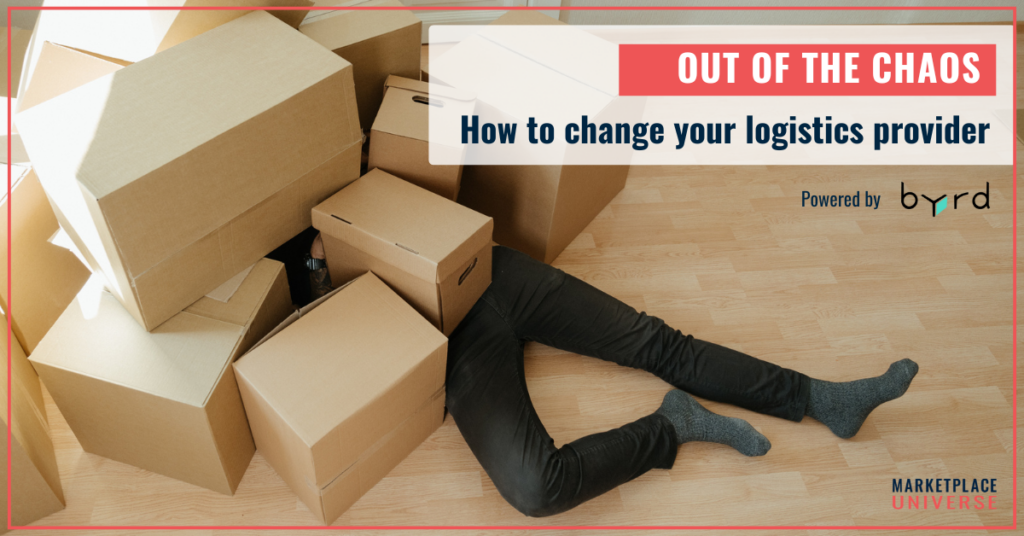
No marketplace business without logistics. But what do you do when more and more customers are complaining or leaving negative comments, when delivery times can no longer be met, storage space is running out or costs are spiraling out of control? So what do you do when logistics go awry, how can a smooth change be ensured?
Many retailers can tell you a thing or two about this: inefficient and error-prone processes, for example due to poor synchronization of inventories, a lack of transparency in costs that come at the expense of margins – these are all warning signs that may necessitate a change of fulfillment or logistics partner. Alternatively, a retailer may simply outgrow the services offered by their existing partner, just as one might outgrow a pair of shoes that have become too small: the storage capacity is no longer sufficient for the increased volume of goods, the necessary warehouse locations for a planned international expansion are missing, or additional services such as a returns portal or organic certification for an expanded range are needed.
But how does a retailer find a suitable new logistic or fulfillment partner?
Here are the most important steps for a smooth change:
1. Define requirements:
- What volume must the fulfillment or logistics partner be able to handle?
- Which integrations are needed?
- Which markets should be covered?
- Are the requirements of the marketplaces in terms of fulfillment SLAs and returns handling met?
2. Obtain offers and compare providers:
- Technical possibilities & integrations: Is seamless integration with e-commerce systems, the ERP and the marketplaces available?
- Locations: Is the necessary proximity to the most important markets given?
- Fulfillment SLAs: Is same-day fulfillment, next-day delivery, etc. possible?
- Sufficient expertise: e.g. in terms of multichannel fulfillment, product categories, etc.
- Shipping service provider setup: Does the provider offer the necessary flexibility (different partners for national or international shipping, for different product sizes, etc.)?
- Scalability: Can the partner keep pace with further growth?
3. Plan onboarding & testing:
- Negotiate and fine-tune the offer based on requirements
- Define timeline & plan onboarding
- Test shipments
Other important factors include communication – is there a dedicated account manager, especially for onboarding? – and value-added services such as a returns portal, customized packaging solutions or similar. It is also good to check the infrastructure at the warehouse locations and make sure they are well connected to carrier hubs.
Last but not least, a clear cost calculation is needed. Since fulfillment and logistics service providers often use very different pricing structures, there is a high risk of comparing apples and oranges.
Tip: Calculate the total costs based on one or more typical orders. This takes a lot of work up front, but it pays off later. This is because it quickly becomes clear where a service provider demands surcharges and how significant these are. In addition, costs for extra services such as integration, the account manager, reporting or similar should be taken into account.

Petra Dobrock, Chief Commercial Officer & Co-Founder of byrd, explains how the switch can be implemented in practice:
Once a retailer has decided to change their logistics service provider, what tasks are involved?
Petra: Above all, a well-structured project plan is needed to minimize downtime. The first step is to inform suppliers that all products are to be delivered to the new warehouse address in the future. At the same time, offboarding at the old warehouse must be organized. It is also important to provide the new warehouse with all the information needed to start warehousing and fulfillment immediately. If there is a brief downtime, customers should be informed in good time. And don’t forget: after a certain point, returns should only be sent to the new warehouse.
How much time should a retailer plan for the technical integration, IT testing and training of employees?
Petra: That depends heavily on the complexity of the system. With us, integration can be done in just five minutes using a standard API. Creating the products and configuring the account usually takes no longer than a day. Training employees takes place step by step during the onboarding process. Based on our experience, you should plan for a total of about three to five weeks, including delivery to the new warehouse.
What is the best way to move goods to new warehouse locations, with a “big bang better” or a gradual transition?
Petra: Both approaches have their advantages and disadvantages. For a smaller product range and a more manageable setup, a ‘big bang’, i.e. a complete changeover at once, is suitable. This saves time and is often less complex. However, if there are many SKUs and a more complicated setup, a gradual transition is usually the better choice. The move to a new warehouse should ideally take place when demand is lower. A good way to avoid disruption is to use split fulfillment, where orders are initially processed through the old and new warehouses while the inventory is gradually transferred.
What stumbling blocks do retailers often overlook when planning a change?
Petra: One of the most common stumbling blocks is unrealistic project management. Many retailers underestimate the effort and time required for such a transition. Another point is communication: here it is crucial to be open and proactive with all parties involved. Often, responsibilities are not clearly defined – this applies to both internal teams and external partners. We have learned that close coordination is essential, especially when working with agencies that work with e-commerce companies and are involved in the process. Finally, you should make sure that the IT systems are fully tested, because different technical infrastructures can work differently.
You want to know more? Then take a look at our partner byrd: https://www.getbyrd.com/